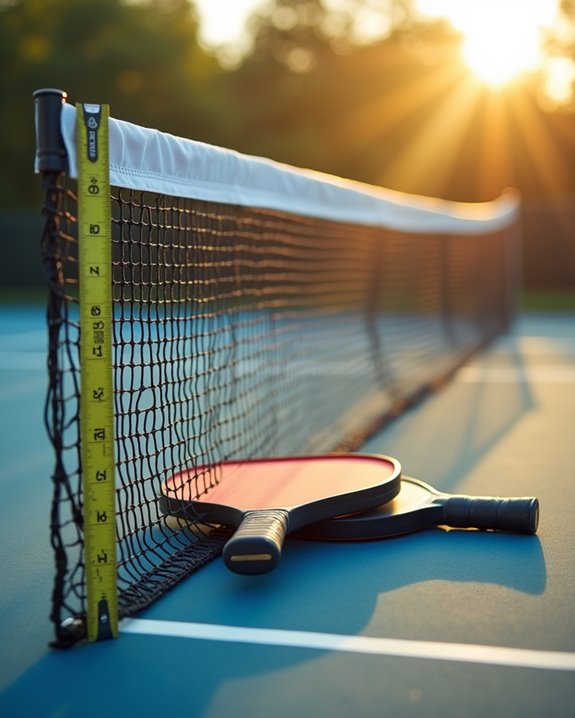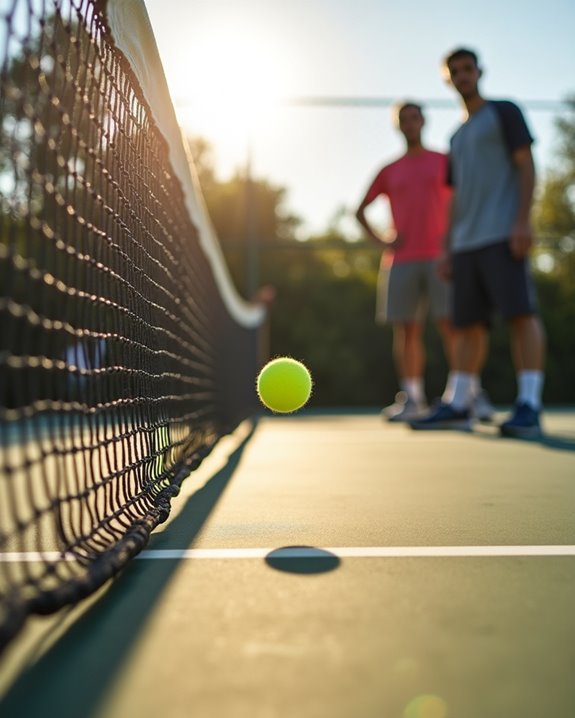In pickleball, you’ll need to announce the score before each serve. For singles, call out two numbers: your score then opponent’s score. In doubles, use three numbers: your team’s score, opponent’s score, and which server you are (1 or 2). Remember to serve from the right court when your score is even, and left when odd. Only the serving team can score points, and games typically go to 11 points (win by 2). The three-number system becomes second nature once you practice calling scores consistently.
Key Takeaways
- Only the serving team can score points, with service switching to the opponent after a fault.
- Singles scoring requires two numbers (server’s score, receiver’s score), while doubles uses three numbers (serving team’s score, receiving team’s score, server number).
- Serve from the right court when your score is even (0, 2, 4) and from the left court when odd (1, 3, 5).
- Games typically go to 11 points with a 2-point margin required to win.
- Always announce the score clearly before each serve to prevent confusion and disputes.
The Basics of Pickleball Point Scoring
The scorekeeping recipe in pickleball might seem like a complex dish at first, but once you’ve mastered the ingredients, you’ll be serving up accurate scores with confidence!
Unlike rally scoring in other sports, only the serving team can earn points when the receiving team commits a fault. You’ll need to call the score clearly before each serve, which keeps everyone on the same page. When your score is even (0, 2, 4…), you’ll serve from the right (deuce) side. With an odd score (1, 3, 5…), you’ll serve from the left (ad) side.
In doubles scoring, you’ll announce three numbers: serving team’s score, receiving team’s score, and server number (1 or 2). Remember to switch sides after each point you score!
Understanding the 11-Point Win System
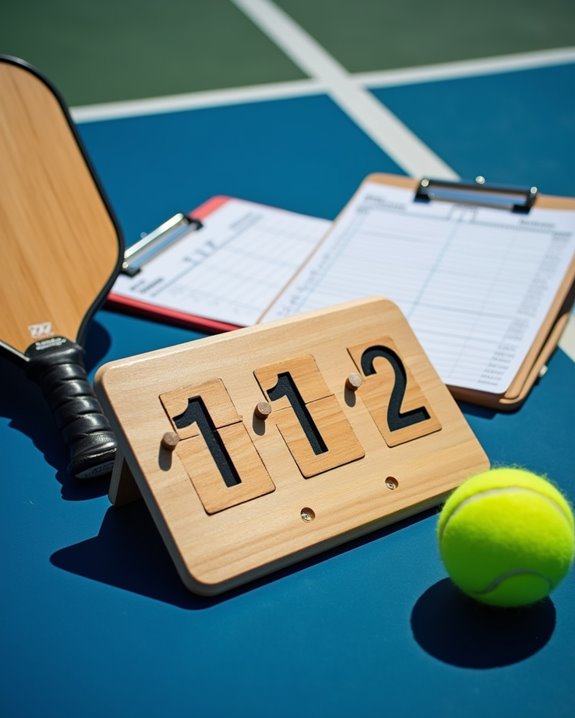
While newcomers often focus on perfecting their dink shots, understanding pickleball’s 11-point win system is the secret sauce that’ll elevate your competitive edge!
Here’s the recipe for victory: you need exactly 11 points and a 2-point margin to win. Remember, only the serving side can score a point—the receiving team merely gains the opportunity to serve when they win a rally.
Scoring in pickleball rewards the server—win to earn points, receive to earn opportunity. Victory demands both 11 points and a 2-point cushion.
When scores sizzle to 10-10, the game continues until someone establishes that vital 2-point margin. Think of it as reducing your competition to a fine reduction!
While tournament formats might increase the target to 15 or 21 points, recreational play typically sticks with 11. This knowledge shapes your strategy—knowing when to play conservatively or when to serve up aggressive shots during critical points.
Announcing Scores in Singles vs. Doubles
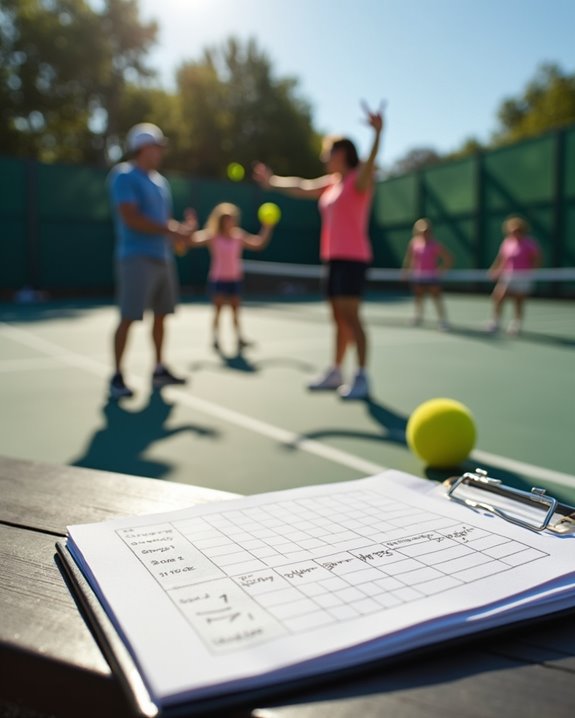
Two distinct scoring announcement systems exist in pickleball, and mastering both is as essential as knowing the difference between folding egg whites and beating them!
In singles, you’ll announce just two numbers: your server’s score followed by the receiving team’s score. For example, “3-2” means you (as server) have 3 points while your opponent has 2.
Doubles play requires a three-number approach, like adding an extra ingredient to your recipe. You’ll call out the serving team’s score, the receiving team’s score, and the server number (first server or second server): “4-3-1” indicates your team has 4 points, opponents have 3, and the first server is serving.
Always announce the score before serving—it’s the perfect way to keep everyone at the kitchen line informed and ready!
Mastering the Three-Number System in Doubles

Understanding doubles scorekeeping in pickleball might seem as complex as perfecting a soufflé, but once you’ve mastered the technique, you’ll serve it up effortlessly!
In doubles, you’ll announce three numbers: first your team’s score, then the opponent’s score, followed by your server number (1 or 2). For example, “6-4-2” means your team has 6 points, they have 4, and your second server is at the line.
The first server always dishes from the right side when the score is even and the left when odd. After scoring, the serving team switches positions while the receiving team stays put. When the serving team faults, the second server steps up. Once both servers fault, it’s the receiving team’s turn to heat things up!
When and Where to Serve Based on Your Score
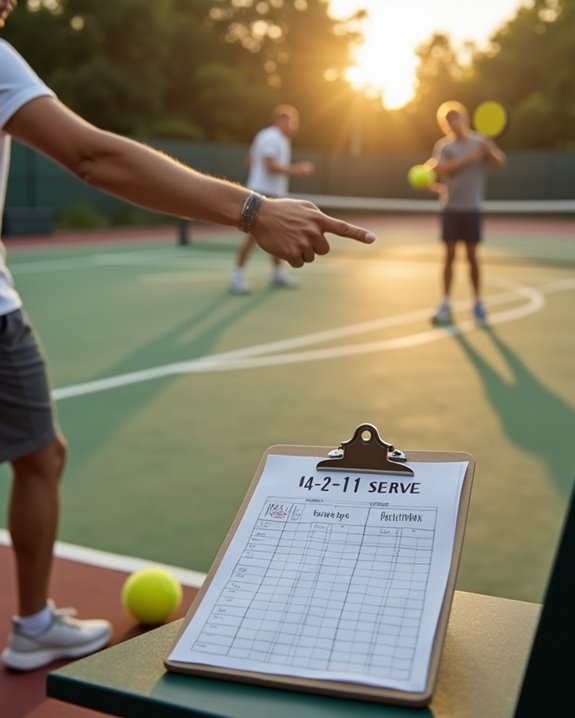
Now that you’ve got the three-number system simmering in your mind, let’s plate up another key ingredient in pickleball scorekeeping: knowing exactly where to serve from based on your score.
Think of the court as your kitchen layout—right side for even scores, left side for odd. In singles, you’ll always begin serving from the right side at 0-0, then alternate sides as your score changes. For doubles, the serving team follows the same recipe: start from the right side and switch based on your score’s parity.
To keep track effortlessly, remember this simple garnish: even scores (0, 2, 4…) mean serving from the right; odd scores (1, 3, 5…) mean serving from the left. Announcing the score before each serve helps everyone digest the game’s progress!
Handling Side-Outs and Server Switches
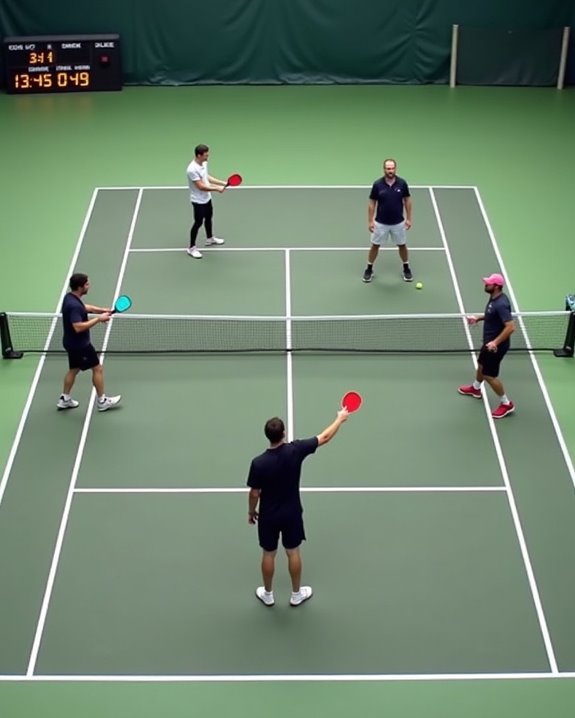
When the rally heats up and ultimately ends with the serving team committing a fault, you’ve just witnessed a side-out—the culinary equivalent of passing the spatula to the other chef. No points are garnished for the serving team’s score during this changeover.
Remember, the first server continues serving until your team loses the rally. Then, your second server takes their turn at the serving line. If the second server loses, it’s a complete side-out.
As players switch sides after scoring, you’ll move to the odd court when your score is odd and the even side when it’s even—just like sorting ingredients into separate bowls. When announcing the score, your team’s score is always first, followed by the opponent’s score and your server number (1 or 2).
Common Scoring Mistakes to Avoid
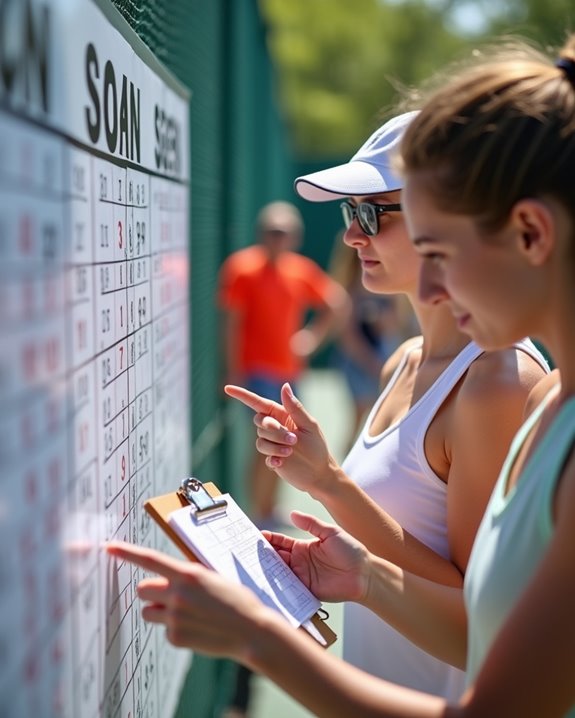
Even the most seasoned pickleball chefs occasionally burn their scoring toast! When serving up points, don’t forget to announce all three ingredients: serving team’s score, receiving team’s score, and server number. This prevents miscommunication during play that could leave everyone with a bad taste.
Remember your court positioning recipe: when your team’s score is even, serve from the right side. Serving from the wrong side is like adding salt instead of sugar—the serving team loses their turn!
In doubles scoring, tracking which server is active (first or second) is essential. It’s the difference between a perfectly timed soufflé and a deflated disaster. Always confirm the score with opponents before serving, like checking your measurements before mixing your pickleball batter!
Adapting to Different Scoring Formats

Pickleball’s scoring menu offers a variety of flavors to satisfy different playing appetites! You’ll need to master both traditional pickleball scoring and rally scoring to become a well-rounded player.
In traditional scoring, only the serving team earns points when they win the rally, like a chef who only gets paid for perfect dishes. Rally scoring, however, allows either team to score regardless of who served—making games move faster, like quick-fire cooking competitions.
When switching between doubles scoring (with its three-number format including server number) and singles, think of it as adapting between complex and simple recipes. Tournament play often features games to 15 or 21 points, while recreational play typically simmers down to 11-point matches with a 2-point margin victory requirement.
Practical Drills to Improve Score-Keeping Skills
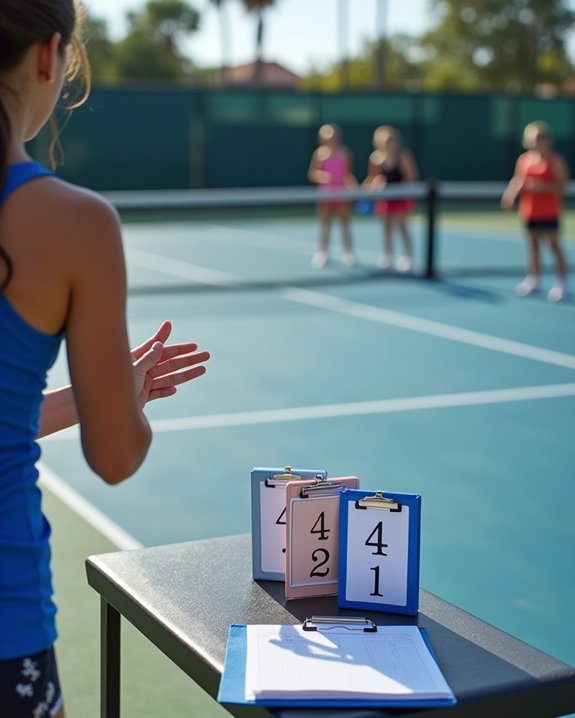
Now that you’re familiar with different scoring formats, let’s heat up your scorekeeping skills with practical training exercises!
Begin by practice calling the score aloud before each serve—think of it as announcing your dish before serving it to guests. Set up mock games where players rotate serving duties while tracking the three-number scoring format. This helps your score recall simmer to perfection under pressure.
Record scores during practice using an app or notepad, folding this habit into your regular routine. Try drills where players intentionally commit faults, requiring you to adjust and announce the updated score—like adjusting seasoning mid-recipe.
Finally, organize mini-tournaments with friends in a competitive context. These real-game scenarios will bake strong score-keeping skills into your pickleball repertoire.
Frequently Asked Questions
How to Keep Score in Pickleball for Dummies?
You’ll never win if you can’t count! Learn scoring methods: call three numbers in doubles (scores + server number), two in singles. Beginners often forget serving rules: serve from right when even, left when odd.
What Is the 10 Second Rule in Pickleball?
You’ve got 10 seconds to serve after the score’s called—it’s proper pickleball etiquette to maintain match pacing. This rule prevents game interruptions, requiring your serve preparation, player focus, time management, court awareness, and competitive spirit.
What Are Three Things You Cannot Do in the Game of Pickleball?
In pickleball, you can’t step into the kitchen to volley, hit the ball twice in succession, or serve from the wrong position. These common fouls break basic pickleball etiquette that beginners should master before developing advanced scoring strategies.
What Is the Golden Rule Pickleball?
The golden rule in pickleball is treating others as you’d want to be treated. While learning the scoring system and game etiquette, remember that respect trumps serve rotation, fault rules, and scoring strategies in creating positive player experiences.




